Name: Cherry, Black
Botanical Name: Prunus serotina
Form: tree
Parts Used: berries
Citation: Guenther, K. (2017, January 12) Black cherry as wildlife food [Web log post.] Retrieved: readers supply the date, from http://wildfoods4wildlife.com
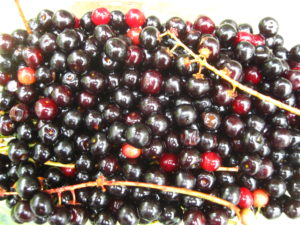
Getting Started
Black cherry fruit can make a case for being a premier native wildlife fruit in the eastern U.S., it ranks #2 on our Favorite Fruits List! Your biggest obstacle to harvesting cherries is going to be finding low hanging fruit. Because the tree is tall, most of the fruit is waaaayyy up there. The second challenge is getting to the fruit before the birds do. But when you find some reachable branches, know that you are picking a fruit that is bound to be a super big hit with your rehab audience! But there are concerns to be mindful of with cherry, so read on to make sure you understand the cyanide risk implications of this wonderful native food.
Rosaceae (Rose Family)
Amygdaloideae (Almond Sub-family)
Prunus (Cherry and Plum Genus)
| Common name | Virginia Prunus Species | Origins | Rare Plant Status |
| allegheny plum | P. alleghaniensis | native | Globally appears secure, but vulnerable in Virginia |
| american wild plum | P. americana | native | rare in some states (not Virginia) |
| chicksaw plum | P. angustifolia | native | rare in some states (not Virginia) |
| sweet plum | P. avium | non-native | not rare |
| Carolina laurel cherry | P. caroliniana | native | not rare, |
| cherry plum | P. cerasifera | non-native | not rare |
| sour cherry | P. cerasus | non-native | not rare |
| damson plum | P. domesica | non-native | not rare |
| hortulan plum | P. hortulana | native | not rare |
| mahaleb cherry | P. mahaleb | non-native | not rare |
| beach plum | P. maritima | native | rare in some states (not Virginia) |
| wild goose plum | P. munsoniana | native | not rare |
| Canada plum | P. nigra | native | rare in some states (not Virginia) |
| pin cherry | P. pensylvanica | native | rare in some states (not Virginia) |
| peach | P. persica | non-native | not rare |
| black cherry | P. serotina | native | not rare |
| spring cherry | P. subhirtella | non-native | not rare |
| susquehanna sand cherry | P. susquehanae | native | Globally appears secure, but critically imperiled in Virginia. |
| choke cherry | P. virginiana | native | rare in some states (not Virginia) |

Key Features to Look For
In addition to the identification guide of your choice, here are a couple of features you should see on this tree:
- Dark purple/black fruits
- Bark of mature trees has a “potato chip” or “burnt corn chip” texture
- Small dots on surface of the twigs. These are pores called lenticels that allow for exchange of gases with the air
- Alternate, pointed leaves with fine teeth
- Berries form on drooping, downward hanging clusters (racemes)
- Cherries mature from red to dark black purple when ripe
- Scratched twigs may smell like almond or maraschino cherries
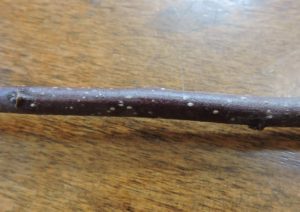
Risks
You may have heard of a danger associated with “stone fruits” which means a fruit that has a single hard seed or “stone” inside a fleshy fruit. For our cultivated fruits, a lot of the “stone fruits” are in the cherry family, so “stone fruit” helps people remember the cherry family members. (But there are a number of wild fruits with single seeds that are not in the cherry family, such as hackberry, greenbrier or dogwood. So this has limited utility in helping us in the wild.) But for those “stone fruits” like apricots, chokecherry, plum, peaches—and yes, cherries— they have chemicals amygdalin and prunasin that combined with certain enzymes turn into hydrogen cyanide (HCN) which is a potent poison. (Cherry is in the Amygdaloideae sub-family taxonomically. Elpel, 2013) The almond scent some people can smell that is associated with scratched or broken cherry twigs is the amygdalin or cyanide, but not everyone can smell this chemical.
A good number of wild mammals eat cherry browse. How can they do this without killing themselves? I honestly cannot say exactly. We know that animals have mechanisms to detox a small quantity of cyanide (Stoltenow & Hardy, 2012). What I do understand is that if an animal eats cherry that has already been damaged– through the process of wilting, chopping or other mechanical damage– the cyanide has had more time to be created and the browse has increased toxicity to a potentially lethal level. The cyanide risk in damaged or wilting leaves continues over time until the leaf is crispy dry and brown. Also, trees stressed by drought have even more cyanide production concentrated in the leaves. Cattle, horses and other livestock have died from eating wilted cherry, like when a storm brings a branch down and it has time to start to wilt before the animals find it. Ruminants– like deer– are the most susceptible to cyanide poisoning which has something to do with the pH of their rumens, but all animals are susceptible.
Seeds, too, can contain the cyanide compounds. But for the cyanide to affect an animal, the seeds sometimes need to be chewed or eaten in super high quantities. The pulp of fruits is not believed to produce cyanide. Most birds and many mammals eat the fruits whole, so the pit just passes through the digestive track without being chewed and thus releasing cyanide. You may have seen bear or raccoon scat full of whole, intact cherry seeds. But even without mastication of the seeds, I would be cautious. Large quantities of cherries have caused cyanide poisoning in animals (Canadian Biodiversity Information System).
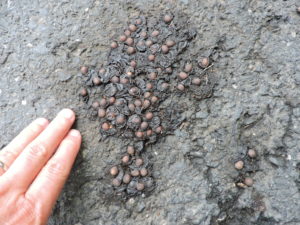
There are two Prunus trees that are particularly high cyanide producers that should be avoided for wildlife use. One is on the Pacific coast, Prunus laurocerasus referred to as cherry laurel or English laurel. It is a non-native ornamental tree.
In the southeast is Prunus caroliniana, Carolina cherry laurel (or Carolina laurelcherry). This is an evergreen shrubby tree that is native but has also been cultivated with many varieties used in the landscaping business, because it is known to be deer resistant. To to play it safe, you may want to avoid harvesting fruits from this particular cherry. Carolina cherry laurel can be distinguished from black cherry easily in two ways. One, the leaf of black cherry is definitely finely serrated (saw-toothed) while Carolina cherry laurel’s leaf is mostly entire (smooth edge) with only occasional or few teeth. Plus it is evergreen. Black cherry drops its leaves.
Here, I have written about the 3 Stop Signs of Cherry to help foragers from inadvertently harvesting cherry browse. But Carolina laurel cherry and Sandcherry defy this simplified mantra because the leaves are barely serrated enough to call them that. If these trees are in your area, take time to learn to recognize them. They are cherry oddballs.
Because all Prunus browse is so dangerous, I have removed it from the database. Read more about cyanide poisoning here.
Flower Description: Clusters of white flowers, cluster almost 6” (15 cm) long when leaves are still young and new, each flower has 5 petals and long stamens.
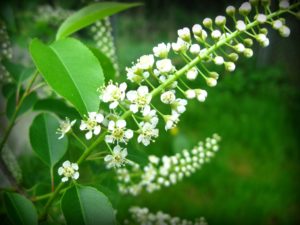
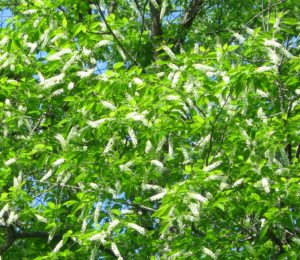
Leaf Description: Dark green and, almond-shaped and shiny, very fine teeth, very pointed tip, brown fuzz on back midrib.
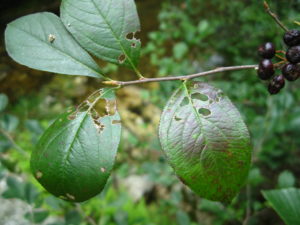
Bark/ Twig Description: Mature black cherry also has a distinctive bark that helps with identification. Some people refer to it as “potato chip” bark—or “burnt cornflake” bark. The bark breaks into blocky ovals and they seem to curl up at the edges. Underneath where they curl up is relatively dark—hence the “burnt” description. Younger bark has light colored dots, dashes or lines horizontally that are the lenticel “pores” where the tree “breathes” typical of cherries and some other trees.
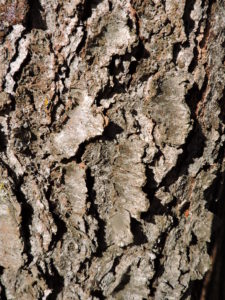
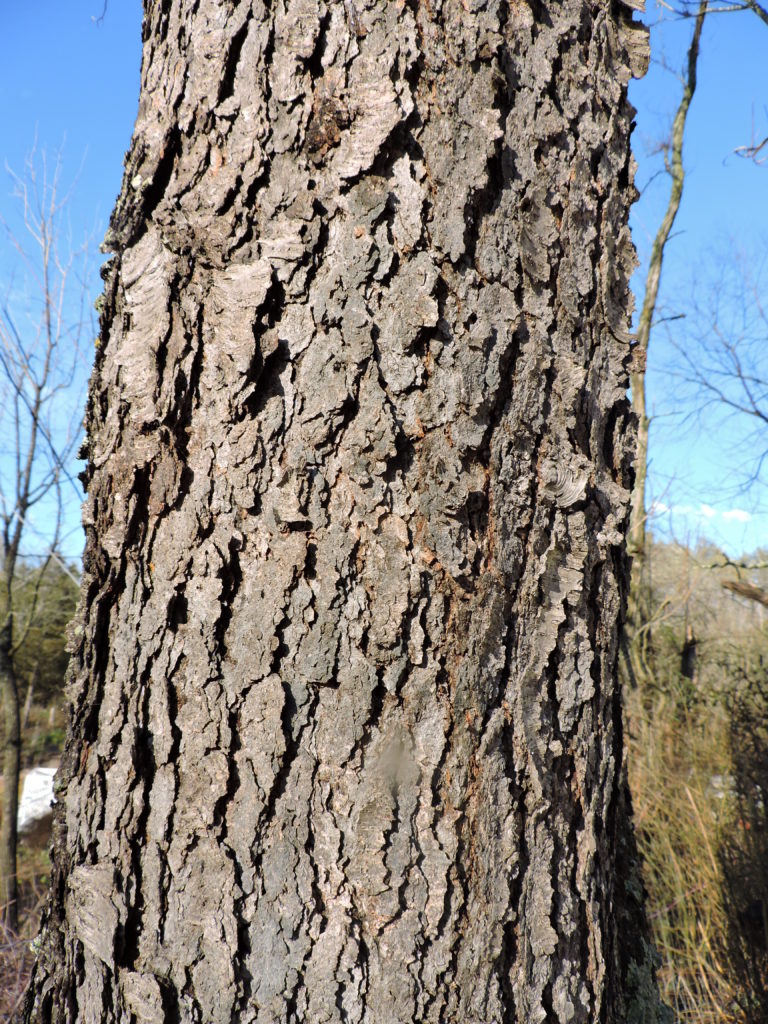
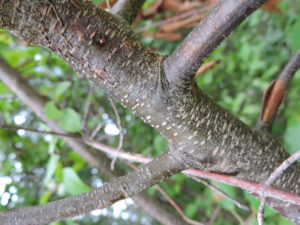
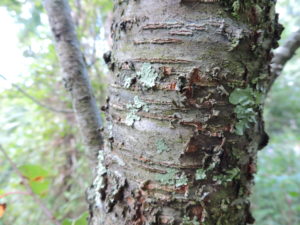
Seed/ Fruit Size: Round, 5/16 inch (7-8 mm), deep purple/black, fruits hang in clusters. Large single light color seed within.
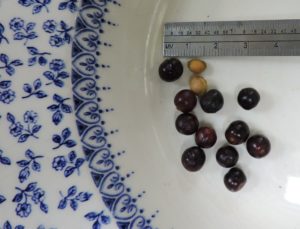
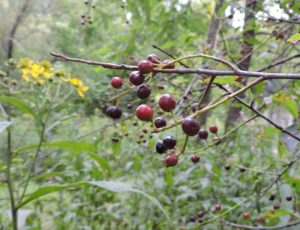
Harvest
| Jan | Feb | Mar | Apr | May | Jun | Jul | Aug | Sep | Oct | Nov | Dec | ||||||||||||||
|---|---|---|---|---|---|---|---|---|---|---|---|---|---|---|---|---|---|---|---|---|---|---|---|---|---|
| winter | winter | late winter | early spring | spring | late spring | early summer | summer | late summer | early fall | fall | late fall | ||||||||||||||
| fruit | x | x | x | ||||||||||||||||||||||
Does this lend itself as a good enrichment item? No. Again, cherry leaves give of cyanide as they wilt. So you never want to offer pruned branches to any animal.
Harvesting Fruit: Handpick fruits directly off the branches you can reach once the fruit has matured to dark purple—almost black. Unripe fruits are green or red.
How to Store Prepared Fruit: Commercial berry containers are great for storing fruit because the rigid plastic keeps fruit from getting crushed and they also have small holes in them which control the humidity in the container. This slows the fruit from drying out too quickly, but allows air circulation to reduce molding.
Cherries keep well in the refrigerator for one to two weeks.
It is ideal to use this fruit fresh, so if at all possible, use them fresh. Frozen fruits just come out dark and mushy, but if you really need to freeze them you can, knowing that the texture will be greatly compromised upon thawing. Nutrients will be preserved. Spread berries in a single layer on a cookie sheet and place in freezer for 1 day. Once frozen, repackage them into zipping freezer baggies (3 mils or thicker) or glass jars to keep them from drying out, remove as much air as possible from the baggie, label and store in freezer until needed—no more than 1 year. Avoid freezing, thawing and refreezing as might happen in a door of a freezer.
See more detailed instructions under the tab “Harvest, Process and Storage.”
Other Species
Because the blooms on cherry trees are so gorgeous and the make great pollinator plants, there are legions of domestic cherry varieties used in the landscaping business. These fruits can be used as well in wildlife rehabilitation just like our native black cherry.
Below are some pictures of domestic cherries I have encountered.
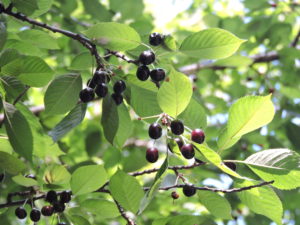
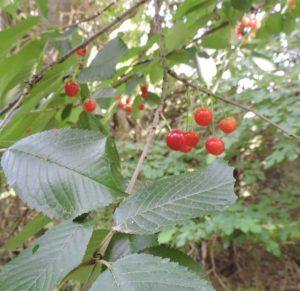
Rare Species in Virginia
Do you live in one of these Virginia counties? If so, be aware that there are some species near you that may be threatened or endangered. Do more research to make sure you are identifying your target species correctly and not harvesting a threatened species!
| County in Virginia | Species |
| Amherst | allegheny plum |
| Augusta | allegheny plum |
| Augusta | susquehanna sand cherry |
| Botetourt | allegheny plum |
| Culpepper | allegheny plum |
| Culpepper | susquehanna sand cherry |
| Fairfax | susquehanna sand cherry |
| Franklin | allegheny plum |
| Giles | allegheny plum |
| Montgomery | allegheny plum |
| Pulaski | allegheny plum |
| Roanoke | allegheny plum |
| Rockbridge | allegheny plum |
| Rockingham | allegheny plum |
| Warren | allegheny plum |
Feed Cherry Fruits to:
cherry, black | (Prunus serotina) | fruit |
|---|---|---|
 Caution: Prunus spp. leaves, twigs and seeds are extreme high-risk for cyanide poisoning for all animals. Fruit pulp is considered safe, but large quantities of seed in fruit can be toxic.(Canadian Biodiversity Information Facility, 2013) | ||
Bear, American Black | Ursus americanus | strong preference |
Cottontail, Eastern | Sylvilagus floridanus |
|
Fox, Red | Vulpes vulpes |
|
Bluebird, Eastern | Sialia sialis |
|
Cardinal, Northern | Cardinalis cardinalis |
|
Catbird, Gray | Demetella carolinensis |
|
Chat, Yellow-bellied | Icteria virens |
|
Crow, American | Corvus brachyrhynchos |
|
Flycatcher, Great-crested | Myiarchus crinitus |
|
Grosbeak, Rose-breasted | Pheucticus ludovicianus |
|
Kingbird, Eastern | Tyrannus tyrannus |
|
Mockingbird, Northern | Mimus polyglottos |
|
Starling, European | Sturnus vulgaris |
|
Tanager, Summer | Piranga rubra |
|
Thrasher, Brown | Toxostoma rufum |
|
Thrush, Gray-cheeked | Catharus minimus |
|
Thrush, Hermit | Catharus guttatus |
|
Thrush, Swainson's | Catharus ustulatus |
|
Thrush, Wood | Hylocichla mustelina |
|
Veery | Catharus fuscescens |
|
Vireo, White-eyed | Vireo griseus |
|
Bobwhite, Northern | Colinus virginianus |
|
cherry, pin | (Prunus pensylvanica) | fruit |
 Caution: Prunus spp. leaves, twigs and seeds are extreme high-risk for cyanide poisoning for all animals. Fruit pulp is considered safe, but large quantities of seed in fruit can be toxic.(Canadian Biodiversity Information Facility, 2013) | ||
Bear, American Black | Ursus americanus |
|
Raccoon, Northern | Procyon lotor |
|
Bluebird, Eastern | Sialia sialis |
|
Robin, American | Turdus migratorius |
|
Grouse, Ruffed | Bonasa umbellus |
|
cherry, wild | (Prunus spp.) | fruit |
 Caution: Prunus spp. leaves, twigs and seeds are extreme high-risk for cyanide poisoning for all animals. Fruit pulp is considered safe, but large quantities of seed in fruit can be toxic.(Canadian Biodiversity Information Facility, 2013) | ||
Bear, American Black | Ursus americanus | strong preference |
Chipmunk, Eastern | Tamias striatus |
|
Cottontail, Eastern | Sylvilagus floridanus |
|
Fisher | Martes pennanti |
|
Fox, Eastern Gray | Urocyon cinereoargenteus |
|
Fox, Red | Vulpes vulpes |
|
Hare, Snowshoe | Lepus americanus |
|
Mouse, Common White-footed | Peromyscus leucopus |
|
Mouse, Deer | Peromyscus maniculatus nubiterre |
|
Opossum, Virginia | Didelphis virginiana |
|
Raccoon, Northern | Procyon lotor |
|
Skunk, Spotted | Spilogale putorius |
|
Skunk, Striped | Mephitis mephitis |
|
Squirrel, American Red | Tamiasciurus hudsonicus |
|
Squirrel, Eastern Fox | Sciurus niger |
|
Squirrel, Eastern Gray | Sciurus carolinensis |
|
Vole, Meadow | Microtus pennsylvanicus |
|
Voles, various spp. | various species |
|
Catbird, Gray | Demetella carolinensis | strong preference |
Flicker, Northern | Colaptes auratus | strong preference |
Grosbeak, Evening | Coccothraustes vespertinus | strong preference |
Grosbeak, Rose-breasted | Pheucticus ludovicianus | strong preference |
Robin, American | Turdus migratorius | strong preference |
Starling, European | Sturnus vulgaris | strong preference |
Tanager, Summer | Piranga rubra | strong preference |
Thrasher, Brown | Toxostoma rufum | strong preference |
Thrush, Bicknell's | Catharus bicknelli | strong preference |
Thrush, Gray-cheeked | Catharus minimus | strong preference |
Thrush, Swainson's | Catharus ustulatus | strong preference |
Blackbird, Red-winged | Agelaius phoeniceus |
|
Bluebird, Eastern | Sialia sialis |
|
Cardinal, Northern | Cardinalis cardinalis |
|
Chat, Yellow-bellied | Icteria virens |
|
Cowbird, Brown-headed | Molothrus ater |
|
Crow, American | Corvus brachyrhynchos |
|
Finch, Purple | Carpodacus purpureus |
|
Flycatcher, Great-crested | Myiarchus crinitus |
|
Goldfinch, American | Carduelis tristis |
|
Grackle, Common | Quiscalus quiscula |
|
Grosbeak, Blue | Guiraca caerulea |
|
Jay, Blue | Cyanocitta cristata |
|
Junco, Dark-eyed | Junco hyemalis |
|
Kingbird, Eastern | Tyrannus tyrannus |
|
Meadowlark, Eastern | Sturnella magna |
|
Mockingbird, Northern | Mimus polyglottos |
|
Oriole, Baltimore | Icterus galbula |
|
Oriole, Orchard | Icterus spurius |
|
Phoebe, Eastern | Sayornis phoebe |
|
Sapsucker, Yellow-bellied | Sphyrapicus varius |
|
Sparrow, Chipping | Spizella passerina |
|
Sparrow, House | Passer domesticus |
|
Sparrow, Song | Melospiza melodia |
|
Sparrow, White-crowned | Zonotrichia leucophrys |
|
Sparrow, White-throated | Zonotrichia albicollis |
|
Tanager, Scarlet | Piranga olivacea |
|
Thrush, Hermit | Catharus guttatus |
|
Thrush, Wood | Hylocichla mustelina |
|
Titmouse, Tufted | Baeolophus bicolor |
|
Towhee, Eastern | Pipilo erythrophthalmus |
|
Veery | Catharus fuscescens |
|
Vireo, Red-eyed | Vireo olivaceus |
|
Vireo, Warbling | Vireo gilvus |
|
Vireo, White-eyed | Vireo griseus |
|
Bobwhite, Northern | Colinus virginianus |
|
Grouse, Ruffed | Bonasa umbellus |
|
Grouse, Sharp-tailed | Tympanuchus phasianellus |
|
Pheasant, Ring-necked | Phasianus colchicus |
|
Turkey, Wild | Meleagris gallopavo |
|
Turtle, Eastern Box | Terrapene carolina |
|
chokecherry | (Prunus virginiana) | fruit |
 Caution: Prunus spp. leaves, twigs and seeds are extreme high-risk for cyanide poisoning for all animals. Fruit pulp is considered safe, but large quantities of seed in fruit can be toxic.(Canadian Biodiversity Information Facility, 2013) | ||
Cottontail, Eastern | Sylvilagus floridanus |
|
Fox, Red | Vulpes vulpes |
|
Flycatcher, Great-crested | Myiarchus crinitus |
|
laurelcherry, Carolina | (Prunus caroliniana) | fruit |
 Caution: Prunus spp. leaves, twigs and seeds are extreme high-risk for cyanide poisoning for all animals. Fruit pulp is considered safe, but large quantities of seed in fruit can be toxic.(Canadian Biodiversity Information Facility, 2013) | ||
Robin, American | Turdus migratorius |
|
Sparrow, Henslow's | Ammodramus henslowii |
|
plum, American | (Prunus americana) | fruit |
 Caution: Prunus spp. leaves, twigs and seeds are extreme high-risk for cyanide poisoning for all animals. Fruit pulp is considered safe, but large quantities of seed in fruit can be toxic.(Canadian Biodiversity Information Facility, 2013) | ||
Bear, American Black | Ursus americanus |
|
Coyote | Canis latrans |
|
Fox, Eastern Gray | Urocyon cinereoargenteus |
|
Fox, Red | Vulpes vulpes |
|
Raccoon, Northern | Procyon lotor |
|
Squirrel, Eastern Fox | Sciurus niger |
|
Squirrel, Eastern Gray | Sciurus carolinensis |
|
Flicker, Northern | Colaptes auratus |
|
Grouse, Sharp-tailed | Tympanuchus phasianellus |
|
Book References:
Elpel, T.J. (2013) Botany in a Day (APG). Pony, Montana: Hops Press, LLC.
Martin, A.C., Zim, H.S., Nelson, A.L. (1951). American Wildlife and Plants: A Guide to Wildlife Food Habits. New York: Dover Publications.
Scott, M. (2013). Songbird Diet Index. National Wildlife Rehabilitators Association, St. Cloud, MN.
Townsend, J. F. (2015, April) Rare Plants Natural Heritage Technical Report 15-10. (Unpublished Report) Richmond, Virginia: Virginia Department of Conservation and Recreation, Division of Natural Heritage.
Virginia Department of Forestry (2010). Common Native Trees of Virginia: Tree Identification Guide.
Online References:
Anderson, Michelle D. 2004. Prunus pensylvanica. In: Fire Effects Information System, [Online].
U.S. Department of Agriculture, Forest Service, Rocky Mountain Research Station, Fire Sciences Laboratory (Producer).
Available: http://www.fs.fed.us/database/feis/ [2016, December 20].
Canadian Poison Plants Information System. (n.d.) Retrieved on 8/6/17 from the Canadian Biodiversity Information Facility at http://www.cbif.gc.ca/eng/species-bank/canadian-poisonous-plants-information-system/canadian-poisonous-plants-information-system/?id=1370403266275
Uchytil, Ronald J. 1991. Prunus serotina. In: Fire Effects Information System, [Online]. U.S. Department of Agriculture, Forest Service, Rocky Mountain Research Station, Fire Sciences Laboratory (Producer).
Available: http://www.fs.fed.us/database/feis/ [2016, December 20].
USDA, NRCS. 2015. The PLANTS Database (http://plants.usda.gov, 4 February 2016). National Plant Data Team, Greensboro, NC 27401-4901 USA.
Virginia Botanical Associates. (Accessed February 2, 2016). Digital Atlas of the Virginia Flora (http://www.vaplantatlas.org). c/o Virginia Botanical Associates, Blacksburg.
